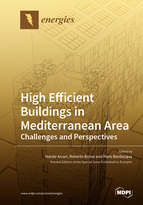High Efficient Buildings in Mediterranean Area: Challenges and Perspectives
A special issue of Energies (ISSN 1996-1073). This special issue belongs to the section "G: Energy and Buildings".
Deadline for manuscript submissions: closed (20 July 2020) | Viewed by 34388
Special Issue Editors
Interests: energy system optimization for building application; energy flows management in smart-grids; cognitive buildings; solar energy modelling; building energy demand reduction; thermal characterization of materials; energy regulations
Special Issues, Collections and Topics in MDPI journals
Interests: thermal analysis of building components using a climatic chamber; passive systems in buildings to reduce thermal energy requirements; measurement of climatic quantities; net- and near-zero-energy buildings; double-skin systems in existing buildings; innovative technologies for building air conditioning; solar cooling; innovative photovoltaic generators; cogenerative and trigenerative photovoltaic systems; high-efficiency and variable-flow air conditioning systems; models for the intelligent management of building-plant systems with cognitive algorithms; back cooling of PV systems; innovative thermal storage systems; green roofs; heat pumps combined with active solar systems; energy recovery from the LNG regasification process; biofuel production from intensive production of microalgae within photo-bioreactors
Special Issues, Collections and Topics in MDPI journals
Interests: green roofs; green solutions; energy saving in buildings; photovoltaic systems; innovative air-conditioning systems; dynamic simulation of buildings and plants; experimental analysis of thermal properties
Special Issues, Collections and Topics in MDPI journals
Special Issue Information
Dear Colleagues,
The Guest Editor is inviting submissions to a Special Issue of Energies on the subject area of “High Efficient buildings in Mediterranean Area: Challenges and Perspectives”.
Design and operation of high efficient low-energy buildings in Mediterranean area can be a challenging task because of the often balanced requirement for heating and cooling energy. Several systems and technologies have been recently proposed in order to optimize the building envelope and the air-conditioning plant, to opportunely control and manage energy requirements and to attain valuable design procedures in function of the building typology and the climatic context.
This Special Issue will deal topic related to the assessment and evaluation of systems and technologies for building energy management and control in Mediterranean climate, aimed at the optimization of the building-plant system and the reduction of energy use.
Topics of interest for publication include, but are not limited to:
- Energy demands reduction in Mediterranean area;
- nZEB design for Mediterranean area;
- Exploitation of building thermal inertia;
- Renewable sources application in nNEB and N-ZEB;
- Passive systems for the building envelope;
- Smart air conditioning plant for building energy minimization;
- Hybrid plants based on renewable sources;
- Demand side management for building energy use optimization;
- Energy storage system for building application;
- Solar assisted heat pump to increase the renewable use in buildings;
Prof. Dr. Natale Arcuri
Dr. Roberto Bruno
Dr. Piero Bevilacqua
Guest Editors
Manuscript Submission Information
Manuscripts should be submitted online at www.mdpi.com by registering and logging in to this website. Once you are registered, click here to go to the submission form. Manuscripts can be submitted until the deadline. All submissions that pass pre-check are peer-reviewed. Accepted papers will be published continuously in the journal (as soon as accepted) and will be listed together on the special issue website. Research articles, review articles as well as short communications are invited. For planned papers, a title and short abstract (about 100 words) can be sent to the Editorial Office for announcement on this website.
Submitted manuscripts should not have been published previously, nor be under consideration for publication elsewhere (except conference proceedings papers). All manuscripts are thoroughly refereed through a single-blind peer-review process. A guide for authors and other relevant information for submission of manuscripts is available on the Instructions for Authors page. Energies is an international peer-reviewed open access semimonthly journal published by MDPI.
Please visit the Instructions for Authors page before submitting a manuscript. The Article Processing Charge (APC) for publication in this open access journal is 2600 CHF (Swiss Francs). Submitted papers should be well formatted and use good English. Authors may use MDPI's English editing service prior to publication or during author revisions.
Keywords
- Mediterranean climate
- nZEB
- Building envelope
- Energy demand
- Passive systems
- Energy savings
- Energy Storage System
- Renewable Energy
- Air-conditioning plant








